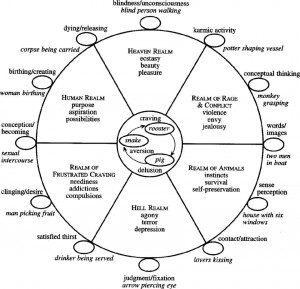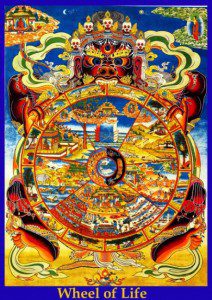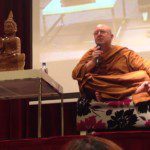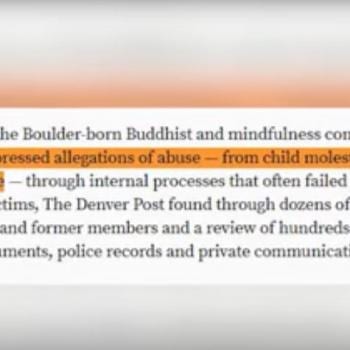In this presentation, University of Toronto graduate student Sean M. Smith discusses the relationship between humans and other animals in the psychological and cosmological teachings of early Buddhism.
I knew I would like the talk after the first 30 seconds, when he said:
As a philosopher I am not interested in contingent historical details. I’m interested in truth, and I think Buddhist Philosophy, and especially Buddhist Philosophy in its early Indian guise – sometimes called the Theravadin school of Buddhism – is a deeply coherent and powerful philosophical model of the mind. And it is buoyed by and anchored by a very robust moral psychology, which I think when understood in the cosmological context of Buddhism … that this school of Buddhism can give us a very powerful lens for thinking about our relationship to animals…
In his talk, Smith uses the “Wheel of Life” or “Wheel of Being” (Bhavacakra) to illustrate the various realms in Buddhist cosmology and the predominant mental states associated with each realm.
From an explication of this image, he segues into the five aggregates (khandha / skandha) before showing the very touching video of a young child refusing to eat his octopus because he cannot understand why people would harm and eat animals, ultimately bringing his mother to tears:
The one hang-up I had while watching it came when Smith suggested that the Buddha’s path amounts to a hypothetical imperative; that is, if you wish to be free from suffering, then this is the prescribed path. In philosophical terms this is distinguished from the categorical imperative, which would say regardless of your personal drives, desires, and inclinations, this is the prescribed path. My own understanding of the Buddha’s teachings are that it is in fact a categorical imperative – that in reality all beings should follow the path to the best of their ability, whether they particularly want to or not. As the Dhammapada states:
129. All tremble at violence; all fear death. Putting oneself in the place of another, one should not kill nor cause another to kill.
130. All tremble at violence; life is dear to all. Putting oneself in the place of another, one should not kill nor cause another to kill.
Even though some thinkers, including Zizek, have argued that this is empirically false and thus Buddhism is wrong, the point being made is that below any mask of bravado or ideologically led suicidal violence, there is still a being who is deeply fearful and clinging to life. Thus the Buddha’s Dhamma (as teachings or the ‘truth’ to which they point) is akin to the Kantian Moral Law.
In any case, Kant is my hobby-horse, so it should be expected that I would defend a Kantian reading of early Buddhism, and many wiser than me have argued that no such reading can/should be done. Mr. Smith’s lecture is admirable in its scope and accessibility and I look forward to seeing more from this young academic.
Watch the full lecture here (and be sure to stick around for some of the very thoughtful student questions after):














